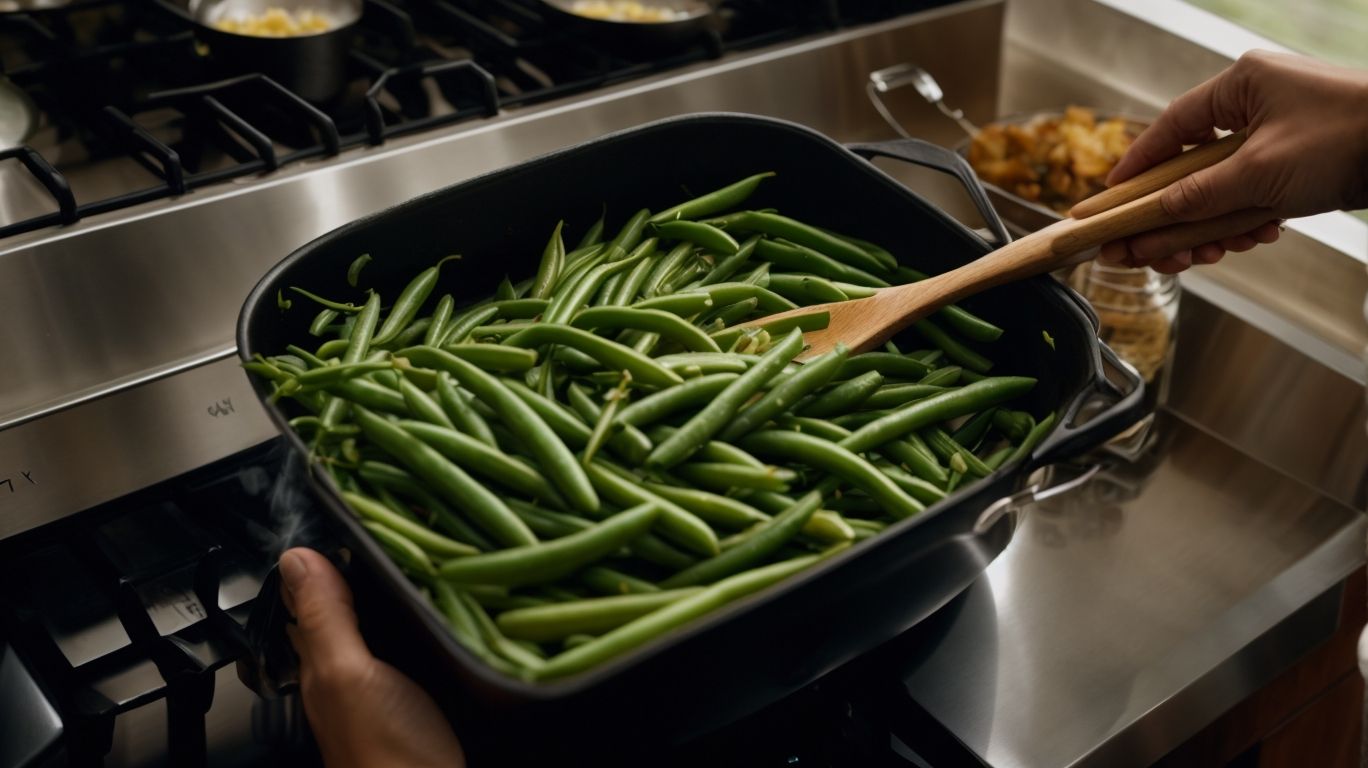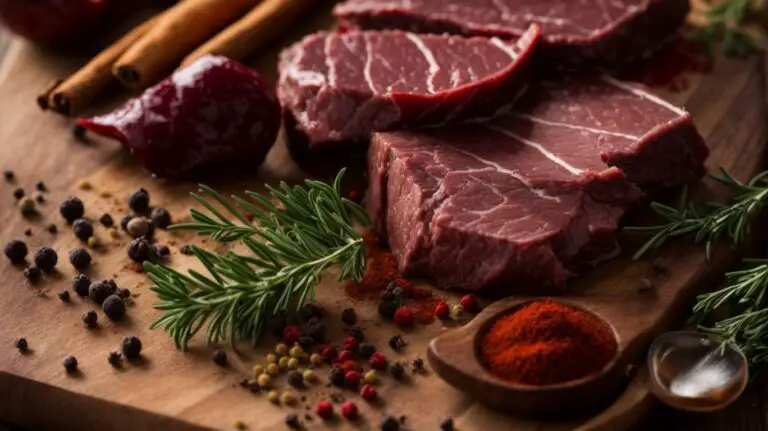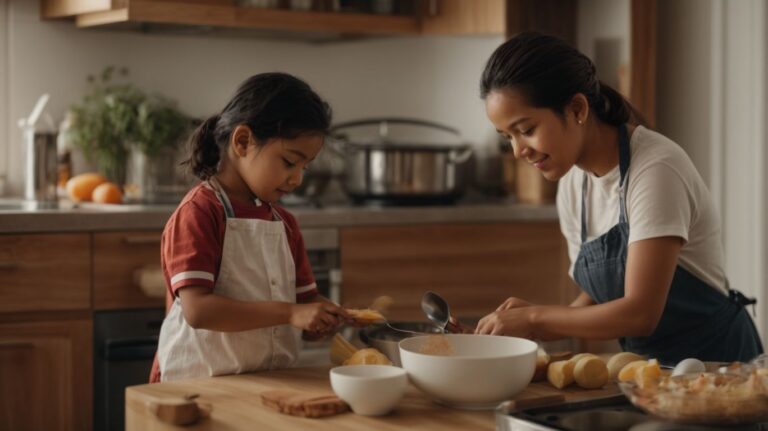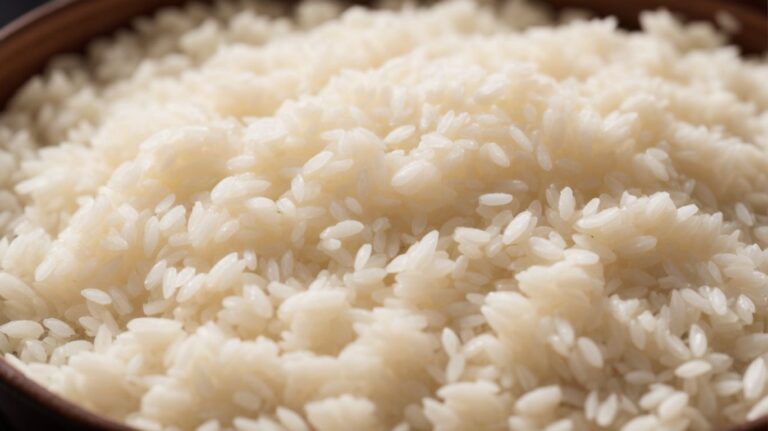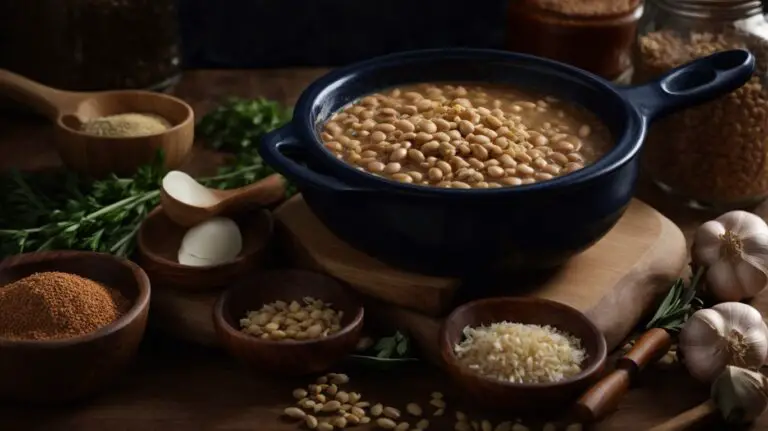How to Cook Green Beans Without a Steamer?
Are you looking to cook green beans without a steamer?
We discuss the benefits of using a steamer for cooking green beans, as well as alternative methods like boiling, sautéing, and roasting.
We also share valuable tips on how to achieve the perfect green beans without a steamer and offer delicious serving suggestions to pair with your cooked green beans. Let’s get cooking!
Key Takeaways:
Why Use a Steamer to Cook Green Beans?
Using a steamer to cook green beans offers numerous benefits, ensuring that the beans retain their nutrients, color, and texture while being cooked to perfection.
Steaming is a gentle cooking method that helps maintain the nutritional value of the green beans, as it does not involve submerging them in water, preventing nutrient loss from leaching out.
Steaming enhances the natural flavor of the beans without the need for excessive seasoning, allowing the true essence of the vegetable to shine through.
Steaming guarantees consistent results each time, ensuring that the green beans are neither undercooked nor overcooked, but just right for a delightful dining experience.
Benefits of Using a Steamer
Steaming green beans offers a healthier cooking method that helps retain vital nutrients and vibrant colors, resulting in tender and flavorful beans.
When you steam green beans, the gentle cooking process keeps the nutrients intact, ensuring that you get the maximum benefits from this nutritious vegetable. Steaming not only helps to preserve the vibrant green color of the beans but also maintains their crisp texture, enhancing the overall visual appeal of your dish. By steaming green beans, you can elevate their natural flavors without the need for excess fats or seasonings, providing a delicious and wholesome addition to your meals. The simplicity of steaming allows green beans to shine in their purest form, making them a versatile and nutritious ingredient for various recipes.
How to Cook Green Beans Without a Steamer
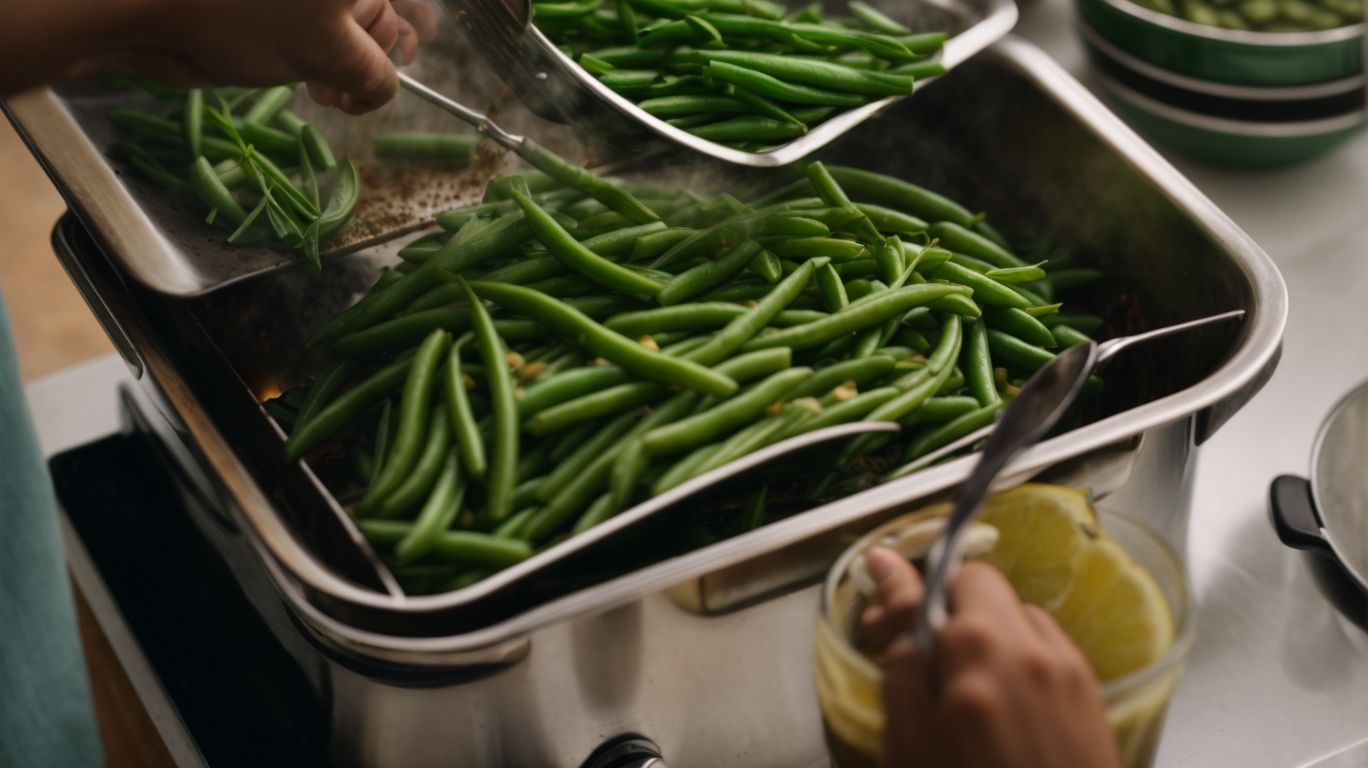
Credits: Poormet.Com – Eugene Nguyen
When a steamer is not available, there are alternative methods to cook green beans, such as boiling, sautéing, or roasting, each offering a unique flavor profile and texture.
-
Boiling green beans is a quick and straightforward method. Start by bringing a pot of water to a boil, add salt, and then the green beans. Cook for about 5-7 minutes until they are tender but still vibrant in color. Drain and season to taste.
-
Sautéing involves cooking the green beans in a pan with some oil or butter over medium-high heat. Add seasonings like garlic or lemon zest for extra flavor. Toss the beans frequently until they are slightly browned and tender.
-
Roasting green beans brings out a delicious caramelized flavor. Preheat your oven, toss the beans with olive oil, salt, and pepper, then spread them on a baking sheet. Roast until they are crispy on the edges, usually around 15-20 minutes.
Method 1: Boiling
Boiling green beans is a simple and effective method that involves cooking the beans in a saucepan filled with water until they reach the desired tenderness.
To start, ensure that you use enough water to fully cover the green beans in the saucepan. The ideal water-to-bean ratio is usually around 4 cups of water for every pound of beans. Once the water is boiling, add a pinch of salt to enhance the flavor. It’s recommended to keep an eye on the beans and test their tenderness periodically. Typically, green beans will become tender after simmering for about 5-7 minutes, depending on their size. Adding a sprig of fresh herbs like thyme or a squeeze of lemon juice can elevate the flavor profile of the beans.
Method 2: Sautéing
Sautéing green beans in a skillet with oil or butter imparts a delicious flavor and slight caramelization, creating a savory dish with a crispy texture.
When sautéing green beans, it is essential to heat your skillet over medium-high heat before adding the oil or butter, ensuring the beans cook evenly and develop that desired caramelization.
The sizzling sound as the beans hit the hot skillet signifies the start of their transformation. Sprinkling a pinch of salt helps enhance the natural flavors of the beans, while a touch of garlic or a squeeze of lemon juice can elevate the dish to new heights.
Cook the green beans for around 5-7 minutes, tossing them occasionally to prevent burning and ensure even cooking. The vibrant color and crunchiness indicate that they are perfectly cooked and ready to be served.
Method 3: Roasting
Roasting green beans in the oven with a drizzle of oil and seasonings creates a crispy exterior and tender interior, resulting in a flavorful and healthy dish.
To achieve the perfect roasted green beans, start by preheating your oven to 400°F (200°C) for optimal cooking temperature. Spread the seasoned green beans on a baking sheet lined with parchment paper in a single layer to ensure even roasting. Remember to shake the pan halfway through cooking to promote uniform browning. The roasting process typically takes around 20-25 minutes, depending on your desired level of crispiness. The high heat of the oven enhances the natural sweetness of the green beans, creating a delicious caramelization that complements various dishes.
Tips for Cooking Green Beans Without a Steamer
When preparing green beans without a steamer, follow these essential tips to enhance the flavor, texture, and overall appeal of your dish.
Start by selecting fresh, firm green beans that are vibrant in color and free from blemishes.
- Before cooking, trim the ends of the beans and remove any tough strings.
- For added flavor, consider blanching the beans in boiling water for a minute before cooking.
Seasoning options can vary from simple salt and pepper to more complex garlic, lemon zest, or herbs like thyme and dill.
Cook the green beans until they are tender but still crisp, usually around 5-7 minutes in boiling water or when they develop a vibrant green color if frying or sautéing. Remember to monitor the heat to prevent overcooking, which can result in a mushy texture.
Choose Fresh Green Beans
Selecting fresh green beans is crucial for a vibrant and flavorful dish, ensuring that the beans are crisp, tender, and packed with nutrients.
When choosing fresh green beans, look for ones that are firm, vibrant green in color, and free of any blemishes or spots. A good tip is to select beans that snap easily when bent, indicating their freshness.
Once you’ve selected your beans, the next step is trimming them.
To trim green beans, simply snap off the stem end by hand or use a knife to cut off any tough or woody parts. It’s essential to wash the beans thoroughly under cold running water to remove any dirt or debris before cooking.
Trim and Wash the Green Beans
Trimming and washing green beans before cooking is essential to remove any impurities or tough ends, ensuring a clean and enjoyable eating experience.
In terms of trimming green beans, the first step is to inspect each bean individually. Look for any discolored spots, blemishes, or ends that appear dry and tough. Use a sharp knife or kitchen shears to snip off these unwanted parts, making sure to maintain a uniform length for even cooking.
After trimming, it’s time to wash the green beans thoroughly. Fill a large bowl with cold water and submerge the beans, gently swishing them around to dislodge any dirt or debris. For stubborn dirt, you can lightly scrub the beans with a vegetable brush. Rinse them under running water to ensure all impurities are removed.
Use a Non-Stick Pan
Utilizing a non-stick pan when cooking green beans without a steamer reduces the risk of sticking and promotes even cooking, resulting in well-prepared and visually appealing dishes.
The use of a high-quality non-stick pan ensures that the green beans maintain their vibrant color and crisp texture, enhancing their overall taste.
When selecting a non-stick pan for this task, opt for a durable and oven-safe option to allow for versatile cooking methods.
Managing the heat properly is essential; start by preheating the pan over medium heat before adding the green beans. Be mindful not to overcrowd the pan, allowing enough space for proper air circulation and even cooking.
Cooking techniques such as sautéing or stir-frying work best to achieve that perfect balance of tenderness and slight crunch in the green beans, elevating your culinary experience.
Seasoning Options
Experiment with various seasoning options such as herbs, spices, garlic, or lemon zest to enhance the flavor profile of your green beans and create enticing culinary combinations.
Amp up the taste of your green beans by incorporating fresh rosemary and thyme to infuse a fragrant earthiness, or try a sprinkle of smoked paprika for a hint of smokiness.
For a zesty twist, a touch of grated lemon zest can brighten up the dish, while a dash of cumin adds a warm, aromatic depth to the flavors.
If you’re feeling adventurous, consider a pinch of red pepper flakes for a subtle kick, or some toasted sesame seeds for a nutty crunch.
Cooking Time and Temperature
Adjusting the cooking time and temperature according to your preferred level of tenderness ensures that your green beans are cooked to perfection, neither undercooked nor overcooked.
One method to determine the ideal doneness of green beans is by inserting a fork into a bean; if it pierces through easily, they are ready. Testing the beans regularly is important to avoid overcooking. Watch the heat level; simmering is preferred over boiling for maintaining texture. Consider variations in size and freshness of the beans when calculating cooking times. Utilizing a timer or setting a timer on your stove can help in managing and adjusting the cooking duration efficiently.
What Can You Serve With Cooked Green Beans?
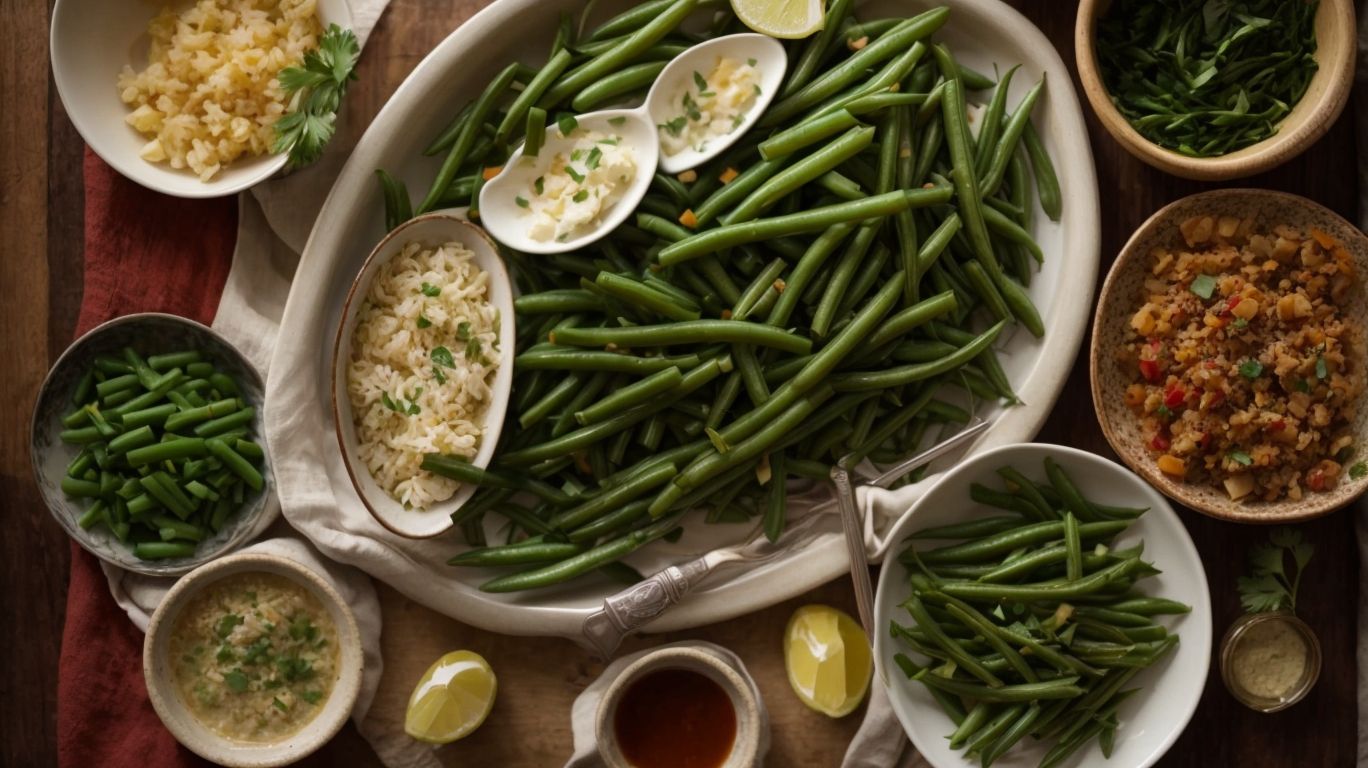
Credits: Poormet.Com – Ryan Nguyen
Green beans pair well with a variety of dishes, including grilled meats, pasta dishes, rice dishes, and casseroles, offering versatile and complementary meal options.
When serving green beans as a side, consider enhancing their flavor with a sprinkling of garlic, a drizzle of olive oil, or a squeeze of lemon juice for a refreshing touch. These simple additions can elevate the taste profile of the beans and add depth to the overall dish.
For a more robust flavor profile, try incorporating bacon bits, caramelized onions, or toasted almonds to create a savory contrast.
Grilled Meats
Pairing green beans with grilled meats such as steak, chicken, or fish creates a balanced and satisfying meal that combines vibrant vegetables with savory protein sources.
Green beans, with their crispy texture and fresh flavor, add a delightful crunch to complement the tender juiciness of grilled meats. The slight sweetness of the beans pairs beautifully with the smoky charred notes from the grill, creating a harmonious blend of tastes on the palate.
Not only do green beans provide a rich source of vitamins A, C, and K, but they also offer a good dose of fiber and antioxidants, making them a nutritious addition to any meat-centric dish.
Pasta Dishes
Incorporating green beans into pasta dishes such as primavera, aglio e olio, or pesto adds a refreshing crunch and vibrant color to the meal, elevating the taste and visual appeal.
Green beans, also known as string beans, are a versatile addition to pasta recipes, offering a delightful contrast to pasta’s soft textures. Whether they’re blanched for tender-crisp bites in a primavera or sautéed to caramelized perfection in aglio e olio, their natural sweetness complements the savory notes of the dish.
For a harmonious fusion of flavors, try tossing blanched green beans with lemon zest and toasted almonds in a lemony pesto pasta. The crunch of beans, brightness of lemon, and nuttiness of almonds create a symphony of taste in every bite.
Rice Dishes
Adding green beans to rice dishes such as pilaf, stir-fry, or risotto introduces a crunchy element and vibrant color, enhancing the overall texture and presentation of the dish.
Green beans, when cooked correctly, offer a delightful snap that contrasts beautifully with the softness of rice. One tip is to blanch the green beans before incorporating them into the dish to ensure they retain their bright color and crisp texture. Consider adding roasted garlic or toasted almonds to a green bean and rice pilaf for added depth of flavor.
When serving green bean-infused rice dishes, a sprinkle of fresh herbs like parsley or cilantro can elevate the freshness and aesthetic appeal. For a burst of citrusy flavor, a squeeze of lemon juice over a green bean risotto brings a zesty brightness that complements the earthy tones of the beans.
Casseroles
Green beans are a classic ingredient in casseroles such as green bean casserole, adding a fresh and crisp element to the dish while complementing other flavors and textures.
Their tender yet slightly crunchy texture provides a delightful contrast to creamy sauces and tender meat in casseroles. When properly cooked, they retain their vibrant green color, making them visually appealing in the dish. Green beans also bring a subtle sweetness and earthy undertones that enhance the overall flavor profile.
One popular variation is to top green bean casseroles with crispy fried onions or bread crumbs for added texture and flavor. Incorporating cheese into the casserole can elevate its richness and provide a savory note to balance the green beans’ freshness.
Conclusion
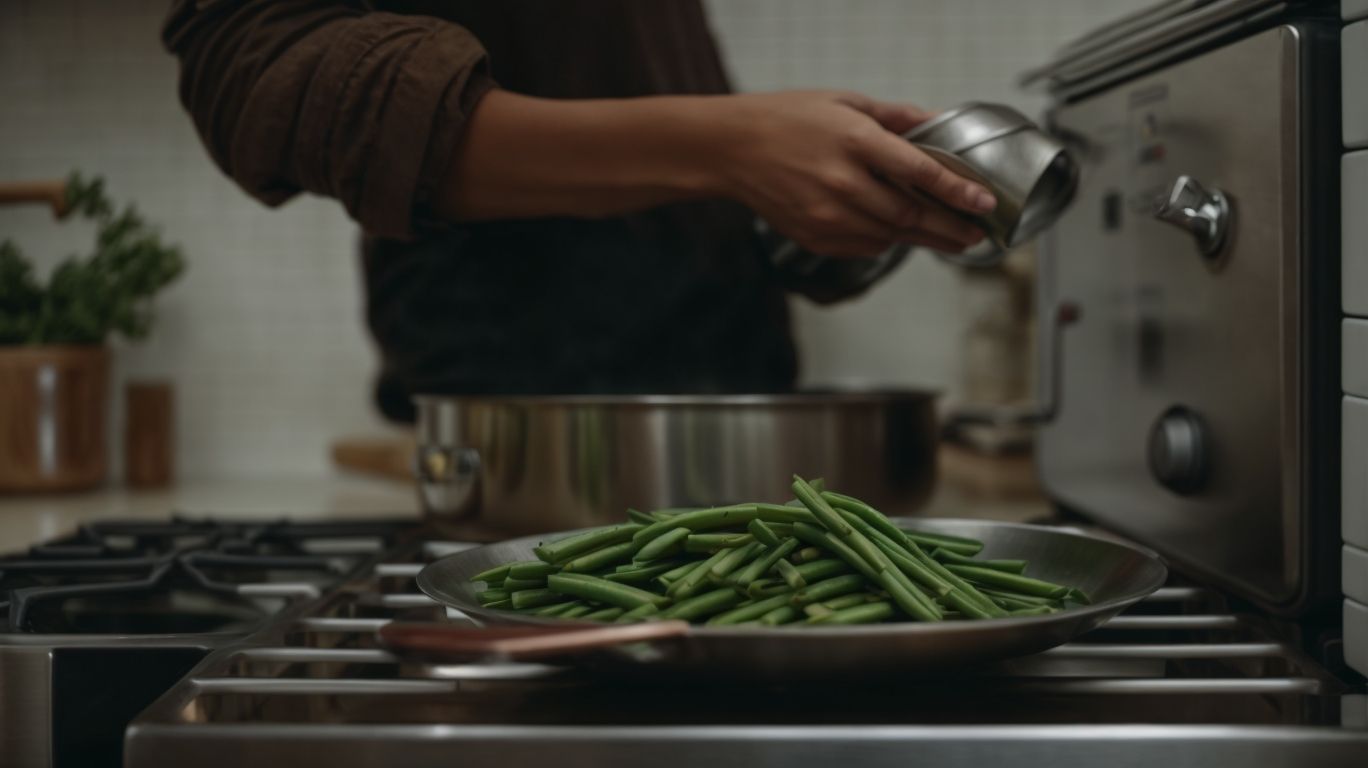
Credits: Poormet.Com – Joe Carter
Utilizing a steamer for cooking green beans offers significant advantages in preserving nutrients, flavors, and textures, leading to delicious and healthy culinary outcomes.
Steaming green beans helps retain essential nutrients like Vitamin C and folate that can be lost in other cooking methods such as boiling or frying.
This gentle cooking process enhances the natural flavors of the beans, resulting in a more vibrant and appetizing dish. Steaming maintains the perfect crisp-tenderness of green beans, ensuring a delightful texture with every bite.
Frequently Asked Questions
How do I cook green beans without a steamer?
There are several ways to cook green beans without a steamer, including blanching, sautéing, roasting, and boiling. Each method offers a unique flavor and texture, so experiment to find your favorite!
Can I cook green beans without a steamer basket?
Absolutely! If you don’t have a steamer basket, you can use a colander or a metal strainer placed over a pot of boiling water. Just make sure the green beans are not touching the water.
How long does it take to cook green beans without a steamer?
The cooking time will vary depending on the method you choose and the size of the green beans. Generally, it takes about 5-7 minutes to cook green beans on the stovetop without a steamer.
Can I cook frozen green beans without a steamer?
Yes, you can! Just make sure to thaw the green beans before cooking and adjust the cooking time accordingly. You can also add spices or seasonings to enhance the flavor.
Can I use a microwave to cook green beans without a steamer?
Yes, you can. Place the green beans in a microwave-safe dish with a small amount of water, cover with a lid or plastic wrap, and microwave on high for 3-4 minutes. Be careful when removing the cover, as steam will escape.
What is the best way to cook green beans without a steamer?
The best method for cooking green beans without a steamer is subjective and depends on personal preference. However, many people enjoy the flavor and texture of sautéed or roasted green beans. Try different methods to find your favorite!

